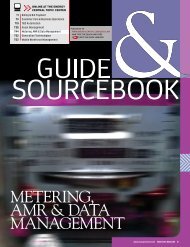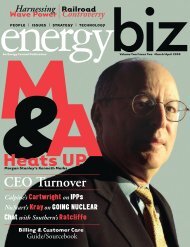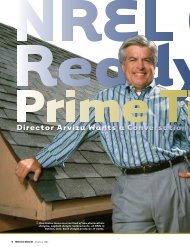View From the Trenches [PDF]
View From the Trenches [PDF]
View From the Trenches [PDF]
Create successful ePaper yourself
Turn your PDF publications into a flip-book with our unique Google optimized e-Paper software.
on topic<br />
Human Resources/Workforce<br />
Management articles from<br />
EnergyPulse<br />
To view any of <strong>the</strong>se<br />
articles, please go to www.<br />
energycentral.com/quicklink<br />
and type <strong>the</strong> quick link code<br />
( ) into <strong>the</strong> quick link box.<br />
Opportunity of Workforce<br />
Aging<br />
Bob Wayland, R. E.<br />
Wayland and Associates<br />
P1269<br />
Crisis Creates<br />
Opportunities<br />
Eve Sprunt, Chevron<br />
P1256<br />
Training for <strong>the</strong> Sake of<br />
Training?<br />
Robert Bowling, Salt<br />
River Project<br />
P1247<br />
Managers As Skilled<br />
Coaches<br />
David Saxby, Measure-X<br />
P1233<br />
Re-thinking Hiring<br />
Strategies<br />
Ken Silverstein, Energy<br />
Central<br />
P1224<br />
Top Employees, Top<br />
Candidates<br />
Tim Brennan, The<br />
Brennan Group<br />
P1177<br />
Work Force, Changing<br />
Industry<br />
Dave Little, Little &<br />
Associates<br />
P1158<br />
Solve HR Challenges<br />
Geoff Gilmore, Climax<br />
Portable Machine Tools<br />
P1121<br />
Generational Differences<br />
in Workplace<br />
Robert Cenek, Cenek Co.<br />
P1107<br />
Energy Career<br />
Opportunities<br />
John Reed, Quinn Reed<br />
Associates<br />
P1109<br />
July/August 2006<br />
At Birmingham-based Alabama Power, Robert Holmes,<br />
senior vice president of ethics and business practices who is also<br />
on <strong>the</strong> board of AABE, acknowledged that Alabama Power in<br />
its 100-year existence “did not have a history of diversity in its<br />
workforce. As we became enlightened, we introduced a strategy<br />
to recruit from a wider demographic.”<br />
Yet Holmes, who has been with Alabama Power for 28 years,<br />
also emphasized that “we recruit talent, not minorities. We’re<br />
trying to form a marriage of diversity and skills.” He noted that<br />
even <strong>the</strong> “people who hang wires and drive trucks” require a twoyear<br />
associate degree to be considered for <strong>the</strong> position.<br />
To overcome <strong>the</strong> glass ceiling, Pinnix-Ragland would like<br />
to see utilities match minority employees with “mentors who<br />
can help <strong>the</strong>m understand <strong>the</strong> corporate culture and develop a<br />
targeted career development plan.”<br />
Hiring more minorities isn’t just <strong>the</strong> right thing to do; it will<br />
help utilities improve <strong>the</strong>ir bottom line, Pinnix-Ragland said. A<br />
diverse workforce brings more innovative thinking and strong<br />
team results which yield greater profits.<br />
Gary Stern, a staff writer for EnergyBiz, is <strong>the</strong> coauthor<br />
of Minority Rules: Turn Your Ethnicitity into a<br />
Competitive Edge, co-written with Kenneth Arroyo<br />
Roldan, (Harper Collins, August 2006), a how-to business<br />
guide to help minorities climb <strong>the</strong> corporate ladder.<br />
<br />
HR MANAGERS ON EMPLOYEE SHORTAGES<br />
BY MATTHEW FOSTER<br />
half of <strong>the</strong> nation’s electrical line workers<br />
will retire. That was <strong>the</strong> grim report on National Public Radio<br />
this spring.<br />
Three years ago, <strong>the</strong> Tennessee Valley Public Power<br />
Association reported that 62 percent of rural electric cooperative<br />
general managers were age 50 or older, as were 61 percent of line<br />
superintendents and 43 percent of line foremen.<br />
To fur<strong>the</strong>r probe <strong>the</strong> looming problem, EnergyBiz in recent<br />
weeks contacted human resources representatives of 15 companies<br />
employing approximately 160,000. They all report that <strong>the</strong>y anticipate<br />
a serious shortage of workers in <strong>the</strong> next few years. Skilled<br />
tradesmen — specifically line technicians, but also mechanics<br />
— are where <strong>the</strong> shortages are expected to be most severe. A lack of<br />
engineers is also an area of concern.<br />
To keep <strong>the</strong>se positions filled, <strong>the</strong> most common new recruiting<br />
strategy being developed by human resources specialists is to<br />
reach out to young workers.<br />
“Staffing for utilities in general has become more challenging; we<br />
are all competing for <strong>the</strong> same dwindling resources because less people<br />
<br />
BY MARTIN ROSENBERG<br />
There is Beth Perlman at Constellation<br />
Energy.<br />
Wendy Welsh is at LG&E Energy.<br />
Patricia Lawicki works at PG&E.<br />
And Rebecca Blalock is at Sou<strong>the</strong>rn<br />
Company.<br />
All head up strategically important<br />
information technology at <strong>the</strong>ir utilities.<br />
In fact, chief information officers at<br />
21 percent of <strong>the</strong> top 100 utilities are<br />
female, according to new data assembled<br />
by Accenture.<br />
Kathryn Sanders, who heads up global<br />
systems integration for utilities at<br />
Accenture and is based in Atlanta, said<br />
that she ordered up <strong>the</strong> study of CIO<br />
ranks when she noticed that many of <strong>the</strong><br />
utility CIOs she encounters are female.<br />
Like many, Sanders believed utilities are<br />
male dominated. Fur<strong>the</strong>rmore, she said,<br />
“we are constantly hearing that women<br />
are falling behind in math and science.”<br />
Despite those views, <strong>the</strong> new evidence<br />
of <strong>the</strong> growing importance of women<br />
in addressing utility technology needs<br />
makes sense. “Women are very good at<br />
putting technology needs into bigger<br />
contexts,” Sanders said. Utilities will<br />
increasingly pay attention to female job<br />
applicants for management assignments<br />
as <strong>the</strong>y deal with attrition caused by an<br />
aging workforce, Sanders predicted. Still,<br />
women have not gained easy access to<br />
<strong>the</strong> “C” suite of executive jobs.<br />
Accenture also studied <strong>the</strong> ranks<br />
of utility chief financial officers and<br />
discovered just 3 percent are woman. “We<br />
see women doing well at <strong>the</strong> controller<br />
level but having difficulty making <strong>the</strong> final<br />
jump to <strong>the</strong> CFO level,” Sanders said.<br />
Susan Tomasky, CFO of American<br />
Electric Power, is one of <strong>the</strong> few who<br />
successfully made <strong>the</strong> leap. Tomasky<br />
said that utility executive management<br />
is traditionally recruited internally from<br />
engineering and operations personnel,<br />
where most are male. A decade ago,<br />
women entering <strong>the</strong> professional ranks<br />
gravitated to technology companies — and<br />
that is probably why a healthy proportion<br />
of <strong>the</strong> utility CIOs today are female, she<br />
said. “The financing area is still hard for<br />
women to crack,” she said. Tomasky, a<br />
lawyer, has experience in regulatory and<br />
corporate finance work. “There still is a<br />
lot of breaking through to do,” she said. “I<br />
expect incremental improvement.”
MEMO FROM HR<br />
“Right now, we’re<br />
making a large push to<br />
market or brand ourselves<br />
to <strong>the</strong> public.”<br />
CLARISSE GRAY // PACIFIC GAS & ELECTRIC<br />
July/August 2006<br />
are moving into <strong>the</strong>se types of jobs,” said Jeanne Myers<br />
at Alliant Energy, in Madison, Wis. “We need to start<br />
building programs in high schools to channel people into<br />
trade or technical schools.”<br />
New recruiting tactics broadly fall into three categories:<br />
establishing <strong>the</strong> utility presence, partnering, and pool<br />
targeting, which is <strong>the</strong> identification and targeting of an<br />
applicant pool.<br />
Some companies indicated that <strong>the</strong>y are concerned<br />
<strong>the</strong> public does not see <strong>the</strong>m as employers.<br />
“When looking for new hires, we have realized that<br />
most of <strong>the</strong> public is not familiar with <strong>the</strong> careers we<br />
offer,” said Ralph Cruz of Colorado Springs Utilities. “We<br />
need to exercise more detail in getting more exposure to<br />
<strong>the</strong> public. We have to make our efforts known to <strong>the</strong><br />
community on a personal basis by letting people know we<br />
offer good careers with good benefits.”<br />
“For niche positions, it’s<br />
hard to find people with<br />
those skills. This will drive<br />
compensation rates higher.”<br />
SHARI SMITH // PROGRESS ENERGY SERVICE<br />
Many companies said <strong>the</strong>y have focused on<br />
increasing <strong>the</strong>ir presence on <strong>the</strong> campuses of universities,<br />
community colleges, trade schools and high<br />
schools. O<strong>the</strong>rs said that that <strong>the</strong>y have established<br />
name-brand initiatives to market <strong>the</strong>mselves.<br />
Young workers are best reached on <strong>the</strong> Internet,<br />
many utilities believe. Four out of five utilities go<br />
online to recruit new workers.<br />
But Walker Witt at South Dakota’s Black Hills<br />
Electric Cooperative, said that he does not use online<br />
resources. Witt said he is still able to use word-ofmouth<br />
and newspapers to recruit new hires. “People<br />
from right-of-way crews, which are basically laborers,<br />
get selected as linemen,” said Witt. Witt and o<strong>the</strong>rs<br />
increasingly recruit internally to fill jobs that require<br />
skilled technicians.<br />
New efforts at outreach are also being tried. “We<br />
have identified recruiting needs by taking an intense<br />
look at what staffing we expect to meet in <strong>the</strong> next five<br />
years,” said Debbi Shimanis of Exelon, in Chicago. “We<br />
have begun to establish feeder pools by reaching out to<br />
community-based organizations, community colleges<br />
and diversity networking groups to see if <strong>the</strong>y can help<br />
us to meet our staffing needs.”<br />
Companies have partnered with community colleges<br />
to develop two-year technical degree programs and<br />
internship cooperatives and have encouraged future<br />
workforce planning development at <strong>the</strong> high school<br />
level. Creativity is required.<br />
“We anticipate a shortage in experience,” said<br />
Miriam Corbin of <strong>the</strong> Board of Lights and Water of<br />
<strong>the</strong> City of Marietta, Ga. “It’s going to be a difficult<br />
time. We’ll have to be creative in how we utilize that<br />
manpower that will be walking out <strong>the</strong> door. I hope our<br />
experienced personnel are able to help us transition.<br />
We’ll need to be flexible with how we use retirees for<br />
part time and consulting.”<br />
Utilities are setting up new systems for evaluating<br />
applicants. O<strong>the</strong>rs are striving to increase diversity in <strong>the</strong>ir<br />
workforce. Some are turning to professional recruiters.<br />
Some believe such efforts should have been launched<br />
years ago.<br />
“As an industry as a whole,<br />
we have waited too long to<br />
deal with this problem.”<br />
ROB DOHERTY // TXU ENERGY
MEMO FROM HR<br />
“Staffing for utilities in general<br />
has become more challenging.<br />
We are all competing for <strong>the</strong><br />
same dwindling resources<br />
because less people are moving<br />
into <strong>the</strong>se types of jobs. We need<br />
to start building programs in<br />
high schools to channel people<br />
into trade or technical schools.”<br />
JEANNE MYERS // ALLIANT ENERGY<br />
July/August 2006<br />
(continued from page 21) a relatively small labor pool, and an<br />
educational foundation in jeopardy. Developmental time<br />
for a technical workforce takes years. Ensuring <strong>the</strong> availability<br />
of a skilled workforce will be critical for a secure and<br />
reliable power system in <strong>the</strong> future. The industry’s future<br />
depends on its ability to anticipate what lies ahead and<br />
develop necessary skilled resources.<br />
Wanda Reder is <strong>the</strong> incoming president-elect of <strong>the</strong><br />
IEEE Power Engineering Society and vice president<br />
of S&C Electric’s power systems services division.<br />
“Our industry has not<br />
done a good job portraying<br />
an open-door<br />
policy to <strong>the</strong> public.<br />
We are our own worst<br />
enemy because we are<br />
looking for candidates<br />
who are too perfect.”<br />
RALPH CRUZ<br />
COLORADO SPRINGS UTILITIES<br />
<br />
REPORT FROM A MARYLAND HIGH SCHOOL<br />
BY CLARK W. HAND<br />
a high school<br />
with a wide range of resources and a student population<br />
covering just about every segment a high school could have.<br />
Not only does <strong>the</strong> school serve a mixed-community area<br />
in Silver Spring, Md., but it also is home to Montgomery<br />
County’s two “magnet” programs, one a nationally recognized<br />
math, science and technology program that draws <strong>the</strong><br />
county’s brightest students. Our resources to teach <strong>the</strong>se<br />
magnet students are commensurate with <strong>the</strong>ir needs and<br />
capabilities.<br />
I’ve recently become aware of a looming and massive<br />
set of changes in our energy industry. Not only is our<br />
professional population aging, so are o<strong>the</strong>r resources,<br />
such as fossil fuels. According to experts, many utility<br />
jobs are going unclaimed or are very difficult to fill,<br />
as few youth have exposure to <strong>the</strong> industry. This<br />
shortage covers <strong>the</strong> global renewable energy field and<br />
electric utilities. This is a dangerous situation, given<br />
our increasing use of energy to run our economy and<br />
our lives.<br />
This school year, we are going through a transition<br />
from more of a traditional “shop” course to a much more<br />
sophisticated engineering or technology course. We are<br />
starting with a focus on preparing students for entry-level<br />
jobs appropriate for youth who have not yet achieved<br />
a college degree. As I’ve worked on my curriculum<br />
transition, I’ve begun to encourage students to work on<br />
projects in two areas. The first is to work on a project of<br />
“We’ll have to be creative<br />
in how we utilize that manpower<br />
that will be walking<br />
out <strong>the</strong> door. We’ll need to<br />
be flexible with how we use<br />
retirees for part time and<br />
consulting. We anticipate<br />
a shortage in experience.”<br />
MIRIAM CORBIN<br />
MARIETTA BOARD OF LIGHTS & WATER


![View From the Trenches [PDF]](https://img.yumpu.com/18854438/1/500x640/view-from-the-trenches-pdf.jpg)













